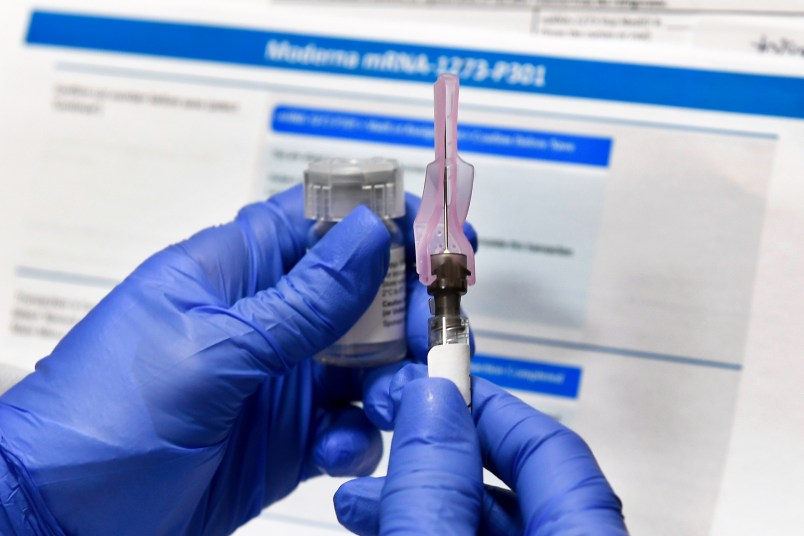The COVID-19 vaccine rollout is so riven with disorganization that it’s difficult for the incoming Biden administration to even ascertain what the problems are.
“I can’t tell you how much vaccine we have, and if I can’t tell it to you then I can’t tell it to the governors and I can’t tell it to the state health officials,” Rochelle Walensky, the new CDC director, told Fox News on Sunday.
That announcement both revealed the scale of the challenge that the Biden administration is up against while also placing reports of fluctuating state vaccine shipments in context: if the federal government that Trump left behind can’t track how much vaccine it has, then state officials may only be experiencing the rippling effects of incompetence at the top.
Walensky’s remarks highlight how deep the problems are in the country’s vaccine distribution system. Though the nation is averaging one million vaccinations per day, it’s also confronting a black box of a radically decentralized distribution system.
Leaving the details of vaccine distribution to the states is what the Trump administration wanted and it’s what it got. In contrast, Biden is putting the federal government at the helm, but there’s a lot of work to do to get a handle on the situation.
White House Press Secretary Jen Psaki would not say on Monday, when asked, that the Biden administration had managed to repair the damage and determine how many doses are available.
“The confusion around this issue, which, we acknowledge, there is confusion, speaks to a larger problem which is what we’re inheriting from the prior administration which is much worse than we could imagine,” Psaki said. “We’re assessing now what we have access to and ensuring that we have more of a rapid engagement with states so they have more of a heads up on what to expect in the weeks ahead.”
State problems
The scale of the problem comes as states around the country struggle with constantly changing totals in the amount of vaccine doses that they’re set to receive.
This has dogged the distribution process since its first days in December, when the Trump administration informed states that they would be receiving up to 50 percent less vaccine doses than originally allocated.
Though that incident was partly resolved after officials with Operation Warp Speed, the Trump administration’s vaccine program, apologized, it set the tone for what was to come.
Since then, the vaccine effort has seen small amounts of doses thrown away due to lack of planning, and far larger instances of vaccination appointments cancelled after dose allocations were cut back at the last minute.
It remains unclear what is causing the fluctuating shipment amounts. State health officials told TPM that the fluctuations occur without explanation, leaving them to scramble to reorganize appointments and distribution chains with one day of warning.
Even Biden officials looking into the problem don’t have a clear sense of what’s going on.
Jeff Zients, the Biden administration’s COVID-19 coordinator, told reporters last week that the federal government would try to improve coordination on the process.
“We hear over and over from governors and local leaders that they just don’t know what supply is coming and can’t plan,” Zients said.
How much vaccine is out there?
The problem may be related to a separate issue: It’s unclear how many doses of COVID-19 vaccine are currently in the system.
Walensky, the new CDC director, addressed this issue in her remarks over the weekend.
But it’s unclear why this is the case. The number of vaccines that Pfizer and Moderna have committed to deliver are fixed by contract, as are the amounts that states are receiving.
It comes after the Biden team had planned on entering government with a rush of extra doses, reversing a Trump administration policy that supposedly held the second dose of the two-dose course in reserve.
But, in its final days, it turned out that the Trump administration had lied. That policy had, in fact, ended in December. There were no second doses being held in reserve.
That caught the states off guard, and has left them in a position where supply is coming nowhere close to meeting demand, even in the relatively limited categories of people to whom vaccines are available.
“There’s just not going to be enough vaccine for everybody,” said Thomas Dobbs, Mississippi state health officer, on the Association for State and Territorial Health Officials podcast.
Dobbs added that the state hadn’t “gotten near enough that much” to finish vaccinating its initial categories of vulnerable recipients.
Dr. Umair Shah, Washington State health secretary, said in a briefing that the Biden administration’s attempt to centralize the system could alleviate the problems. But he emphasized that the speed of the process had made things more difficult.
“When things move fast, nothing is perfect,” he said.







Basic Facts were not a part of the previous administration’s working toolset.
I see what you did there.
Nodeng to see.
Yeah, they get warped.
That announcement both revealed the scale of the challenge that the Biden administration is up against while also placing reports of fluctuating state vaccine shipments in context: if the federal government that Trump left behind can’t track how much vaccine it has, then state officials may only be experiencing the rippling effects of incompetence at the top.